2019年整理肿瘤学考博试题汇总
肿瘤学试题及答案解析
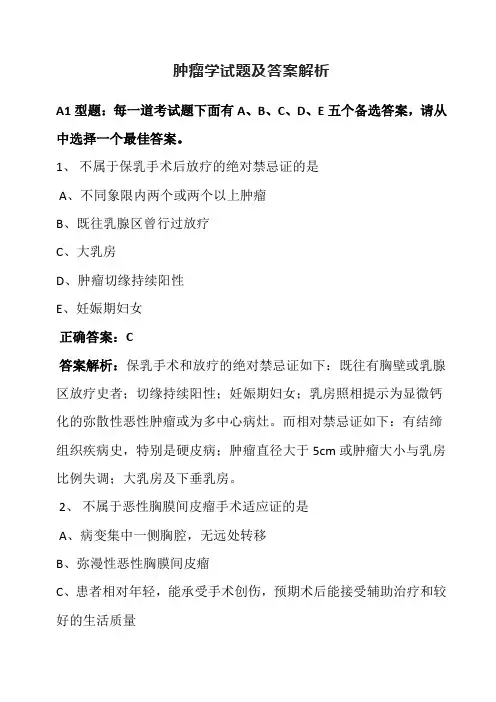
肿瘤学试题及答案解析A1型题:每一道考试题下面有A、B、C、D、E五个备选答案,请从中选择一个最佳答案。
1、不属于保乳手术后放疗的绝对禁忌证的是A、不同象限内两个或两个以上肿瘤B、既往乳腺区曾行过放疗C、大乳房D、肿瘤切缘持续阳性E、妊娠期妇女正确答案:C答案解析:保乳手术和放疗的绝对禁忌证如下:既往有胸壁或乳腺区放疗史者;切缘持续阳性;妊娠期妇女;乳房照相提示为显微钙化的弥散性恶性肿瘤或为多中心病灶。
而相对禁忌证如下:有结缔组织疾病史,特别是硬皮病;肿瘤直径大于5cm或肿瘤大小与乳房比例失调;大乳房及下垂乳房。
2、不属于恶性胸膜间皮瘤手术适应证的是A、病变集中一侧胸腔,无远处转移B、弥漫性恶性胸膜间皮瘤C、患者相对年轻,能承受手术创伤,预期术后能接受辅助治疗和较好的生活质量D、患者伴有难以忍受的胸部疼痛E、反复难以控制的胸腔积液而其他治疗无效正确答案:B答案解析:恶性胸膜间皮瘤手术适应证是:①病变集中一侧胸腔,无远处转移,或者是局限性恶性胸膜间皮瘤(弥漫性恶性胸膜间皮瘤的局限期);②患者相对年轻,能承受手术创伤,预期术后能接受辅助治疗和较好的生活质量;③患者伴有难以忍受的胸部疼痛,或反复难以控制的胸腔积液而其他治疗无效。
3、对Ⅱ期子宫内膜癌,正确的手术方式是A、全宫双附件切除B、次广泛子宫双附件切除C、全官双附件切除+盆腔淋巴结取样D、广泛性子宫、双附件切除+盆腔淋巴结切除E、次广泛子宫双附件切除+盆腔淋巴结切除正确答案:D答案解析:A、B、C选项适用于Ⅰ期子宫内膜癌的手术治疗,D选项适用于Ⅱ期子宫内膜癌的手术治疗,Ⅲ期以上以综合治疗为主,手术切除全宫、双附件、大网膜及转移瘤。
4、对于外耳道骨质有破坏的外耳道癌或中耳癌,最常用的手术术式是A、颞骨次全切除术B、颞骨全切除术C、乳突凿开术D、颞骨肿瘤活检术E、腮腺腺叶切除术正确答案:C答案解析:乳突凿开术的适应证为外耳道骨质有破坏的外耳道癌或中耳癌,乳突凿开术配合放疗是治疗颞骨鳞癌的有效方法。
肿瘤科专业知识考试试题及答案(最全)
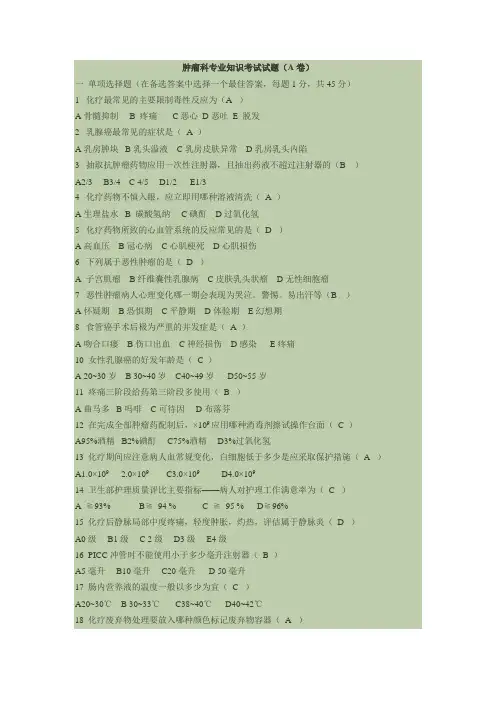
肿瘤科专业知识考试试题(A卷)一单项选择题(在备选答案中选择一个最佳答案,每题1分,共45分)1 化疗最常见的主要限制毒性反应为(A )A骨髓抑制 B 疼痛 C恶心 D恶吐E 脱发2 乳腺癌最常见的症状是( A )A乳房肿块 B乳头溢液 C乳房皮肤异常 D乳房乳头内陷3 抽取抗肿瘤药物应用一次性注射器,且抽出药液不超过注射器的(B )A2/3 B3/4 C 4/5 D1/2 E1/34 化疗药物不慎入眼,应立即用哪种溶液清洗( A )A生理盐水 B 碳酸氢纳 C碘酊 D过氧化氢5 化疗药物所致的心血管系统的反应常见的是(D )A高血压 B冠心病 C心肌梗死 D心肌损伤6 下列属于恶性肿瘤的是(D )A 子宫肌瘤 B纤维囊性乳腺病 C皮肤乳头状瘤 D无性细胞瘤7 恶性肿瘤病人心理变化哪一期会表现为哭泣。
警惕。
易出汗等(B )A怀疑期 B恐惧期 C平静期 D体验期 E幻想期8 食管癌手术后极为严重的并发症是(A )A吻合口瘘 B伤口出血 C神经损伤 D感染 E疼痛10 女性乳腺癌的好发年龄是( C )A 20~30岁B 30~40岁 C40~49岁 D50~55岁11 疼痛三阶段给药第三阶段多使用(B )A曲马多 B吗啡 C可待因 D布落芬12 在完成全部肿瘤药配制后,×109应用哪种消毒剂擦试操作台面( C )A95%酒精 B2%碘酊 C75%酒精 D3%过氧化氢13 化疗期间应注意病人血常规变化,白细胞低于多少是应采取保护措施(A )A1.0×109 2.0×109 C3.0×109 D4.0×10914 卫生部护理质量评比主要指标——病人对护理工作满意率为(C )A ≧93% B≧94 % C ≧95 % D≧96%15 化疗后静脉局部中度疼痛,轻度肿胀,灼热,评估属于静脉炎(D )A0级 B1级 C 2级 D3级 E4级16 PICC冲管时不能使用小于多少毫升注射器(B )A5毫升 B10毫升 C20毫升 D 50毫升17 肠内营养液的温度一般以多少为宜(C )A20~30℃ B 30~33℃ C38~40℃ D40~42℃18 化疗废弃物处理要放入哪种颜色标记废弃物容器(A )A红色 B黄色 C黑色 D白色19 重组粒细胞刺激因子最好在化疗后什么时候使用(B )A12小时 B24小时 C 36小时 D48小时20 化疗废物容器装满多少时不再使用( A )A2/3 B1/3 C3/4 D1/221 环磷酰胺不易溶于水需加热才能完全溶解但需小于多少度( D )A 30℃ B40℃ C50℃ D60℃22 卡培他滨应在餐后何时服用(B )A20分钟 B30分钟 C40分钟 D60分钟23 顺泊必须用何种溶液溶解(A )A生理盐水 B5%葡萄糖 C10%葡萄糖 D灭菌注射用水24 什么是肺癌病人首发症状(A )A咳嗽 B血痰 C胸痛 D发热25 用紫杉醇前口服地塞米松的时间为(A )A6小时 12小时 B4小时8小时 C2小时6小时 D半小时1小时26 疼痛按阶梯给药的顺序为( D )A可待因→吗啡针→阿司匹林 B吗啡针→阿司匹林→可待因C吗啡针→可待因→阿司匹林 D阿司匹林→ 可待因→→吗啡针27 配制化疗药物需戴几副手套( C )A不需要 B1副 C2副 D3副28 所有化疗废物需经多少度高温焚烧灭毒(D )A100℃ B200℃ C 500℃ D 1000℃29 换PICC贴膜时撕膜顺序为( D )A从内至外 B从外至内 C从上至下 D从下至上●30采用数字法评估疼痛时中度疼痛为几分(C )A1~3 B2~5 C4~6 D7~1031 乳腺癌常见而最早转移的淋巴结是(A)A同侧腋下淋巴结 B锁骨下淋巴结 C锁骨上淋巴结 D锁骨旁淋巴结 D对侧腋下淋巴结32胃癌好发的部位是(E)A贲门 B胃底 C胃体小弯侧 D胃体大弯侧 E胃窦33结肠癌最应重视的早期症状是(C)A腹痛 B贫血 C排便习惯改变 D粪便带脓血或粘液 E肿块34胃癌最主要的转移途径是(B)A直接蔓延 B淋巴转移 C血行转移 D腹腔内种植 E消化道转移35下列关于良性肿瘤特征的描述不正确的是(D)A边界清楚 B生长缓慢 C活动度好 D疼痛明显 E形状规则36国际TNM分期法中的M是指(C)A原发肿瘤 B肿瘤部位 C远处转移 D区域淋巴结 E肿瘤的恶性程度37下列有关于肿瘤化疗的护理叙述不正确的是(C)A药物必须现配先用 B药物不可溢出静脉外 C若出现药物外渗,应立即热敷 D每周检查白细胞和血小板计数 E用后的注射器和空药瓶单独处理38放疗病人口腔出现假膜时,应采用的漱口液为( B )A生理盐水 B双氧水 C甘草水 D金银花水 E呋喃西林液39患者李某,男,49岁,患胃癌晚期,病情日趋恶化,病人对医务人员工作不满,常常对陪伴家属发脾气,请问该病人的心理反应属于哪一阶段(B)A否认期 B愤怒期 C忧郁期 D协议期 E接收期40奥沙利铂在静脉治疗时出现渗漏,下面处理最不应该的是哪一项(B)A热敷 B 冷敷 C硫酸镁湿敷 D局部封闭 E喜辽妥外涂41长春新碱属于哪类抗肿瘤药物( D )A细胞毒素类 B抗代谢类 C抗肿抗生素类 D植物类42 PICC置管者封管注射器最佳选择是(C)A 2.5cm注射器B 5ml注射器C 10ml以上注射器D 以上都可以43原发性肝癌转移最早,最常见的是(A)A肝内血行转移 B淋巴转移 C种植转移 D外血行转移44抽吸化疗药物时,要注意抽出的药液不超过注射器容量的( D )A 1/2B 1/3C 2/3D 3/445诊断恶性肿瘤最可靠的依据是(C)A B型超声波B放射性核素检查C 病理检查 D X线造影46肺癌的恶性程度最高的是( B )A鳞状上皮细胞癌 B小细胞末分化癌 C大细胞未分化癌 D腺癌47早期肺癌的特征性症状是(B)A发热 B血丝痰 C哮鸣 D气促48以下哪项不是三阶梯癌痛治疗原则(B)A个体化给药 B按需给药 C口服给药 D按时给药49哪项不是上腔静脉压迫症状(A)A全身浮肿 B头面部及上肢浮肿 C颈静脉怒张 D口唇发青,呼吸困难51 甲状腺次全切除术中患者突然呼吸困难,失音,发绀应考虑(B)A 喉头水肿B 血管压迫气管C 两侧喉返神经损伤D 两侧喉返神经损伤与两侧喉上神经损伤E 两侧喉上神经损伤52对倾倒综合征的认识正确的是(A)A表现为进甜食后上腹部不适,心慌,恶心等B 可出现休克大出血C 长期不愈者可将毕式1式改为毕式2式手术D 为胃肠吻合过小而引起的 E 治疗应先禁食并给予胃肠减压,消炎等53结肠癌最应重视的早期症状是(C)A 腹痛B 贫血C 排便习惯改变D 粪便带脓血或黏液E 肿块54 急性肠梗阻的早期体征是(A)A 腹胀B 绞痛时伴肠鸣音亢进C 肠形蠕动波D 腹部包块E 腹膜刺激症55 能较早发现大肠癌术后复发的检查是(C)A 纤维结肠镜B 坝餐肠造影C 癌胚抗原检查D 直肠指检E 大便隐血实验●56乳房的正确检查方法(A)A 外上,外下,内下,内上、中央各区B 外上,外下,内上,内下中央各区C 中央,内下,内上,外上,外下D 外上,外下,内上,外上,外下E 内下,内上,外下,外上,中央各区57乳房肿瘤最常见的是(B)A 乳癌B 乳房纤维腺病C 乳管外乳头状瘤D 乳管内乳头状瘤E 乳房肉瘤58 胃癌最主要的转移途径是(B)A 直接蔓延B 淋巴转移C 血行转移D 腹腔内种植E 消化道转移60 患者女性,57岁,肺癌晚期行放射治疗,现皮肤高度充血,有水疱,局部有渗出液,该患者的皮肤状况以下说法正确的是(C)A 正常反应B 一度反应C 二度反应D 三度反应E 低蛋白水肿61 通过中心静脉途径进行胃肠外营养支持的病人,估计其接受营养支持的时间至少应为(C)A 3天B 1周C 2周D 3周E 4周62 对于门诊病人,判断甲状腺功能亢进病情程度最简单而主要的指标(B)A 突眼程度B 脉率和脉压C 体重减轻程度D 食欲亢进程度E 甲状腺肿大程度63女性,30岁,月经前乳房胀痛及出现肿块,月经后自行消退,应考虑为(C)A 乳腺癌B 乳腺肉瘤C 囊性增生病D 纤维腺瘤E 乳管内乳头状瘤64 下列关于良性肿瘤特征的描述不正确的是(D)A 边界清楚B 生长缓慢C 活动度好D 疼痛明显E 形状规则65 国际TNM分期法中的M是指(c)A 原发肿瘤B 肿瘤部位C 远处转移D 区域淋巴瘤E 肿瘤的恶性程度66下列有关肿瘤化疗的护理叙述不正确的是(C)A 药物必须新鲜配制B 药物不可溢出静脉外C 若出现药物外渗,应立即热敷,计数。
(完整)肿瘤学试题库肿瘤总论
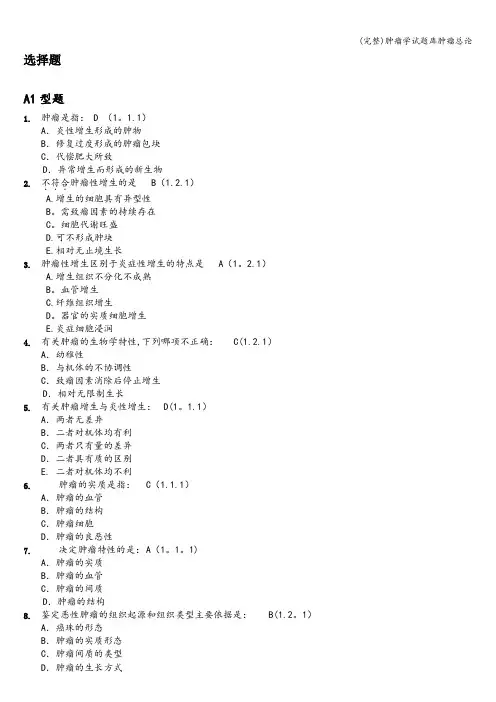
选择题A1型题1.肿瘤是指: D (1。
1.1)A.炎性增生形成的肿物B.修复过度形成的肿瘤包块C.代偿肥大所致D.异常增生而形成的新生物2.不符合...肿瘤性增生的是 B(1.2.1)A.增生的细胞具有异型性B。
需致瘤因素的持续存在C。
细胞代谢旺盛D.可不形成肿块E.相对无止境生长3.肿瘤性增生区别于炎症性增生的特点是 A(1。
2.1)A.增生组织不分化不成熟B。
血管增生C.纤维组织增生D。
器官的实质细胞增生E.炎症细胞浸润4.有关肿瘤的生物学特性,下列哪项不正确:C(1.2.1)A.幼稚性B.与机体的不协调性C.致瘤因素消除后停止增生D.相对无限制生长5.有关肿瘤增生与炎性增生:D(1。
1.1)A.两者无差异B.二者对机体均有利C.两者只有量的差异D.二者具有质的区别E. 二者对机体均不利6.肿瘤的实质是指:C(1.1.1)A.肿瘤的血管B.肿瘤的结构C.肿瘤细胞D.肿瘤的良恶性7.决定肿瘤特性的是:A(1。
1。
1)A.肿瘤的实质B.肿瘤的血管C.肿瘤的间质D.肿瘤的结构8.鉴定恶性肿瘤的组织起源和组织类型主要依据是:B(1.2。
1)A.癌珠的形态B.肿瘤的实质形态C.肿瘤间质的类型D.肿瘤的生长方式E. 肿瘤实质与间质比例9.肿瘤的异型性是指:A(1.2。
1)A.肿瘤与其起源组织的差异B.实质与间质比例的差异C.肿瘤之间大小的差异D.肿瘤之间的形态差异E。
肿瘤生长速度的差异10.区别良恶性肿瘤的重要形态学依据是: D(1。
2.1)A.生长方式B.实质与间质的比例C.生长速度D.异型性E。
间质的类型11.恶性肿瘤异型性主要表现在C(1。
1。
1)A。
肿瘤细胞胞浆嗜碱性B。
可见核分裂C.肿瘤细胞核的多形性D。
肿瘤细胞分泌减少E.组织结构紊乱12.良性肿瘤异型性主要表现在 C (1.1。
1)A.细胞形态不一B.核分裂像增多C.组织结构紊乱D.细胞间变明显E.细胞分泌减少13.不符合...肿瘤形态特点的描述的是 A(2。
医学考博2019真题
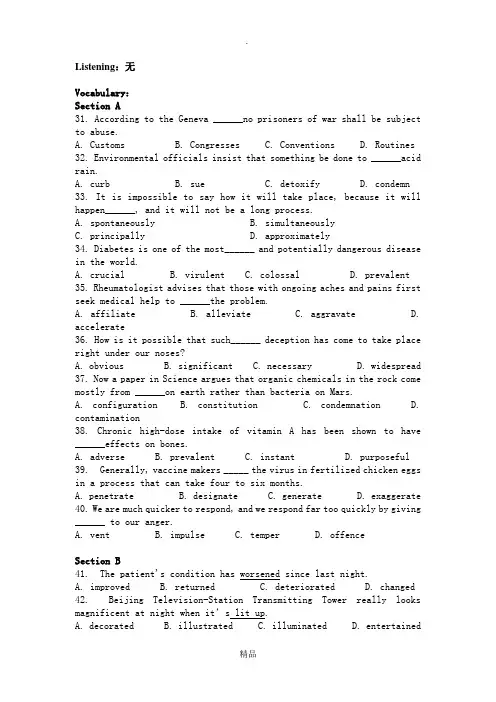
Listening:无Vocabulary:Section A31. According to the Geneva ______no prisoners of war shall be subjectto abuse.A. CustomsB. CongressesC. ConventionsD. Routines32. Environmental officials insist that something be done to ______acidrain.A. curbB. sueC. detoxifyD. condemn33. It is impossible to say how it will take place, because it willhappen______, and it will not be a long process.A. spontaneouslyB. simultaneouslyC. principallyD. approximately34. Diabetes is one of the most______ and potentially dangerous diseasein the world.A. crucialB. virulentC. colossalD. prevalent35. Rheumatologist advises that those with ongoing aches and pains firstseek medical help to ______the problem.A. affiliateB. alleviateC. aggravateD.accelerate36. How is it possible that such______ deception has come to take placeright under our noses?A. obviousB. significantC. necessaryD. widespread37. Now a paper in Science argues that organic chemicals in the rock comemostly from ______on earth rather than bacteria on Mars.A. configurationB. constitutionC. condemnationD.contamination38. Chronic high-dose intake of vitamin A has been shown to have______effects on bones.A. adverseB. prevalentC. instantD. purposeful39. Generally, vaccine makers _____ the virus in fertilized chicken eggsin a process that can take four to six months.A. penetrateB. designateC. generateD. exaggerate40. We are much quicker to respond, and we respond far too quickly by giving______ to our anger.A. ventB. impulseC. temperD. offenceSection B41. The patient's condition has worsened since last night.A. improvedB. returnedC. deterioratedD. changed42. Beijing Television-Station Transmitting Tower really looksmagnificent at night when it’s lit up.A. decoratedB. illustratedC. illuminatedD. entertained43. Attempts to restrict parking in the city centre have further aggravated the problem of traffic congestion.A. amelioratedB. aggregatedC. deterioratedD. duplicated44. The applications of genetic engineering are abundant and choosing one appropriate for this case can be rather difficult.A. sufficientB. plentifulC. adequateD. countable45. The defect occurs in the first eight weeks of pregnancy, though no one understands why.A. deficitB. deviationC. draw backD. discrepancy46. He has been on hormone alternate therapy for four years and looks fantastic.A. successorB. replacementC. surrogateD. choice47. It had over 2,000 apartment complexes, a great market, a large number of industrial workshops, an administrative center, a number of massive religious edifices, and a regular grid pattern of streets and buildings. A. ancient B. carefullyC. very largeD. carefully protected48. When patients spend extended periods in hospital, they tend to become overly dependent and lose interest in taking care of themselves.A. extremelyB. exclusivelyC. exactlyD. explicitly49. The anxious parent was vigilant over the injured child in spite ofa full array of emergency room of doctors and nurses.A. preoccupiedB. unwaryC. watchfulD. dozing50. The doctor vacillated so frequently on disease-prevention techniques that his colleagues accused him of inconsistency.A. waveredB. instigatedC. experimentedD. reliedClozeWe spend a lot of time looking at the eyes of others for social 51 —it helps us understand a person’ emotions, and make decisions about how to respond to them. We also know that adults avoid eye contact when anxious. But researchers have known far 52 about eye gazing patterns in children.According to new research by Kalina Michalska, assistant professor of psychology at the University of California, Riverside, we now, know that anxious children tend to avoid making eye contact, and this has consequences for how they experience fear. The 53 and less frequently they look at the eyes of others, the more likely they are to be afraid of them, even when there may be no reason to be. Her study, “Anxiety Sym ptoms and Children's Eye Gaze During Fear Leaming”, was published in the journal The Journal of Child Psychology and Psychiatry."Looking at someone’s eyes helps us understand whether a person isfeeling sad, angry, fearful, or surprised. As adults, we then make decisions about how to respond and what to do next. But, we know much less about eye patterns in children—so, understanding those patterns can help us learn more about the development of social learning,” Michalska said.Michalska and the team of researchers showed 82 children, 9 to 13 years old, images of two women’s faces on a computer screen. The computer was equipped with an eye tracking device that allowed them to measure 54 on the screen children were looking, and for how long. The participants were originally shown each of the two women a total of four times. Next, one of the images was 55 with a loud scream and a fearful expression, and the other one was not. At the end, children saw both faces again without any sound or scream.The following three conclusions can be drawn from the study:1. All children spent more time looking at the eyes of a face that was paired with the loud scream than the face that was not paired with the scream, 56 they pay attention to potential threats even in the absence of outward cues.2. Children who were more anxious avoided eye contact during all three phases of the experiment, for both kinds of faces. This had consequences for how afraid they were of the faces.3. The more children avoided eye contact;the more afraid they were 57 the faces.The conclusions suggest that children spend more time looking at the eyes of a face when previously paired with something frightening suggesting they pay more attention to potentially threatening information as a way to learn more about the situation and plan what to do next.However, anxious children tend to avoid making eye contact, which leads to greater 58 experience. Even though avoiding eye contact may reduce anxiety 59 , the study finds that—over time—children may be missing out 60_ important social information. This includes that a person may no longer be threatening or scary, and yet the child continues feeling fearful of that person.51. A. environment B. cues C. relations D. answers52. A. less B. more C. enough D. beyond53. A. longer B. more anxious C. shorter D. more54. A. where B. when C. how D. what55. A. followed B. recorded C. paired D. marked56. A. suggest B. suggesting C. suggests D. being suggested57. A. to B. of C.at D. about58. A. fear B. surprise C. sad D. angry59. A. in the long run B. for a long timeC. in the short timeD. in a long time60. A. with B. without C. of D. onReading ComprehensionPassage OneThe British psychoanalyst John Bowlby maintains that separation from the parents during the sensitive “attachment” p eriod from birth to three may sca r a child’s personality and predispose to emotional problems in later life.Some people have drawn the conclusion from Bowlby' s work that children should not be subjected to day care before the age of three because of the parental separation it entails, and many people do believe this. It has been argued that an infant under three who is cared for outside the home may suffer because of the separation from his parents. But there are also arguments against such a strong conclusion.But traditional societies are so different from modem societies that comparisons based on just one factor are hard to interpret. Firstly, anthropologists point out that the insulated love affair between children and parents found in modem societies does not usually exist in traditional societies. For example, in some tribal societies, such as the Ngoni, the father and mother of a child did not rear their infant alone—far from it.Certainty, Bowlby’s analysis raises the possibilities that early day care had delayed effects. The possibility that such care might lead to, say, more mental illness or crime 15 or 20 years later can only explored by the use of statistics. However, statistical studies of this kind have not yet been carried out, and even if they were, the results would certainly be complicated and controversial. Secondly, common sense tells us that day care would not be so widespread today if parents, care-takers found children had problems with it. Thirdly, in the last decade, there have been a number of careful American studies of children in day care, and they have uniformly reported that care had a neutral or slightly positive effect on childre n’s development.Whatever the long-term effects, parents sometimes find the immediate effects difficult to deal with. Children under three are likely to protest at leaving their parents and show unhappiness. At the age of three or three and a half almost all children find the transition to nursery easy,and this is undoubtedly why more and more parents make use of child care at this time. The matter, then, is far from clear-cut, though experience and available evidence indicate early care is reasonable for infants.61. According to the passage, the consequence of parental separation________.A. still needs more statistical studiesB. has been found negative is more seriousC. is obviousD. in modem times62. The author thinks that John Bowlby’s concern___________.A. is relevant and justifiableB. is too strong to RelieveC. is utterly groundlessD. has something that deserve our attention63. What’s the result of American studies of children in day care in the last decade?A. The children’s unhappiness and protest was due to the day car e the children received.B. The bad effects of parental separation were hard to deal with.C. The effect of day care was not necessarily negative on children’s development.D. Early care was reasonable for babies since it’s practiced by so many people nowadays.64. According to the passage, which of the following is probably a reason for parents to send their children under three to day care?A. They don’t know about day care’s negative effect.B. They are too busy to care for their children.C. They want their children to be independent as early as possible.D. They want to facilitate their children to adapt to nursery at the age of about three.65. What’s the author’s attitude to people who have drawn the conclusion from Bowlby’s work that children should not be subjected to day care before the age of three?A. He supports most of their belief because Bowlby's proposition is well-grounded.B. He is sympathetic for them, for he thinks they have been misled by Bowlby.C. He doesn't totally agree with them, since the long-term effect of day care still needs further study.D. He doesn't quite understand them, as they are contradictory in themselves.Passage TwoBy the end of this century, the average world temperature is expected to increase between one and four degrees, with widespread effects on rainfall, sea levels and animal habitats. But in the Arctic, where the effects of climate change are most intense, the rise in temperature could be twice as much.Understanding how Arctic warming will affect the people, animals,plant and marine life and econom ic activity in Canada’s North are important to the country's future, says Kent Moore, an atmospheric physicist at University of Toronto Mississauga who is participating in a long-term, international study of the marine ecosystem along the Beaufort Sea, from Alaska to the Mackenzie delta.The study will add to our knowledge of everything from the extent of sea ice in the region to how fish stocks will change to which areas could become targets for oil and gas exploration to the impact on the indigenous people who call this part of the country home.Moore, who has worked in the Arctic for more than 20 years, says his research hasalready found that thinning sea ice and changes in wind patterns are causing an important change in the marine food chain: phytoplankton(淳游植物)is blooming two to three weeks earlier. Many animals time their annual migration to the Arctic for when food is plentiful, and have not adapted to the earlier bloom. " ' Animals' behavior can evolve over a long time, but these climate changes are happening in the space of a decade, rather than hundreds of year s, ” says Moore, " Animals can't change their behavior that quickly. ”A warmer Arctic is expected to have important effects on human activity in the region, as the Northwest Passage becomes navigable during the summer, and resource extraction becomes more feasible. Information gained from the study will help government, industry and communities make decisions about resource management, economic development and environmental protection.Moore says the study—which involves Canadian, American and European researchers and government agencies will also use a novel technology to gather atmospheric data: remotely piloted drones. "The drones have the capability of a large research aircraft,and they’re easier to deploy,” he says, showing the researchers to gather information on a more regular basis than they would be able to with piloted aircraft.66. By the end of this century, according to the author, global warming will ______.A. start to bring about extreme weather events to humans and animalsB. increase the average world temperature by four degreesC. cause more damages to the whole world than expectedD. affect the Arctic more than any other parts of the earth67.To help understand the destructive mechanism of Arctic warming, as indicated by the passage, the international study ______.A. is conducted with every single discipline of University of TorontoB. pioneers in pursuing the widespread effects of climate changeC. involves so many countries for different investigationsD.is intended to deal with various aspects in research68. When he ways, “Animals can’t change their behavior that quickly,” what does Moore mean by that quickly?A. The migration of the animals to the Arctic.B. The widespread effects of global warming.C. The rate of the climate change in the Arctic.D.The phytoplankton within the marine ecosystem.69. According to the author, to carry out proper human activities in the Arctic______.A. becomes more difficult than ever beforeB. is likely to build a novel economy in the regionC. will surely lower the average world temperatureD. needs the research-based supporting information70. With the drones deployed, as Moore predicts, the researchers will _______.A. involve more collaborating countries than they do nowB. get more data to be required for their researchC. use more novel technologies in researchD. conduct their research at a regular basisPassage ThreeHaving too much caffeine during pregnancy may impair baby’s liver development and increase the risk of liver disease in adulthood, according to a study published in the Journal of Endocrinology. Pregnant rats given caffeine had offspring with lower birth weights, altered growth and stress hormone levels and impaired liver development. The study findings indicate that consumption of caffeine equivalent to 2-3 cups of coffee may alter stress and growth hormone levels in a manner that can impair growth and development, and increase the risk of liver disease in adulthood.Previous studies have indicated that prenatal caffeine intake of 300 mg/day or more in women, which is approximately 2 to 3 cups coffee per day, can result in lower birth weights of their children. Animal studies have further suggested that prenatal caffeine consumption may have more detrimental long-term effects on liver development with an increased susceptibility to non-alcoholic fatty liver disease, a debilitating condition normally associated with obesity and diabetes. However, the underlying link between prenatal caffeine exposure and impaired liver development remains poorly understood. A better understanding of how caffeine mediates these effects could help prevent these health issues in people in the future.In this study, Prof Hui Wang and colleagues at Wuhan University inChina, investigated the effects of low (equivalent to 2-3 cups of coffee) and high dose (equivalent of 6-9 cups of coffee) caffeine, given to pregnant rats, on liver function and hormone levels of their offspring. Offspring exposed to prenatal caffeine had lower levels of the liver hormone, insulin like growth factor (IGF-1), and higher levels of the stress hormone, corticosteroid at birth. However, liver development after birth showed a compensatory 'catch up' phase, characterised by increased levels of IGF-1, which is important for growth.Dr. Yinxian Wen, study co-author, says, “Our results indicate that prenatal caffeine causes an excess of stress hormone activity in the mother, which inhibits IGF-1 activity for liver development before birth. However, compensatory mechanisms do occur after birth to accelerate growth and restore normal liver function, as IGF-1 activity increases and stress hormone signalling decreases. The increased risk of fatty liver disease caused by prenatal caffeine exposure is most likely a consequence of this enhanced, compensatory postnatal IGF-1 activity. ”These findings not only confirm that prenatal caffeine exposure leads to lower birth weight and impaired liver development before birth but also expand our current understanding of the hormonal changes underlying these changes and suggest the potential mechanism for increased risk of liver disease in the future. However, these animal findings need to be confirmed in humans.Dr. Wen comments, "Our work suggests that prenatal caffeine is not good for babies and although these findings still need to be confirmed in people, I would recommend that women avoid caffeine during pregnancy."71. Which of the following is NOT the problem of baby rats of pregnant rats given caffeine?A. Lower birth weight.B. Smaller stress.C. Liver development problem.D. Growth problem.72. If a pregnant woman takes 3 cups of coffee, what will probably happen?A. Her weight will get lower and lower.B. The weight of her baby will get lower and lower.C. She will suffer from non-alcoholic fatty liver disease in a long run.D. Her baby will be more vulnerable to obesity and diabetes because of liver problem.73. Which of following is not correct according to the passage?A. A better understanding of the relationship between caffeine and effects has been achieved.B. 4-5 cups of coffee could be categorized as medium-dose intake.C. Liver development problem may be remedied after birth by increased growth factor.D. The study is mainly conducted on the rats instead of human.74. What is the relationship between stress hormone and liver development when taking in prenatal caffeine?A. Lower stress hormone, lower birth weight before birth.B. Higher stress hormone, lower growth hormone before birth.C. Higher stress hormone, more accelerated growth of weight after birth.D. Lower stress hormone, less accelerated growth of liver after birth.75. What can be the best summary of the last paragraph?A. The r esearch hasn’t been done on humans so pregnant women can ignore the results.B. The compensatory mechanism for liver growth makes prenatal caffeine intake safe.C. Experts suggest pregnant women should still avoid caffeine.D. We have known enough about the hormone changes underlying the healthPassage FourThe bizarre antics of sleepwalkers have puzzled police, perplexed scientists, and fascinated writers for centuries. There is an endless supply of stories about sleepwalkers. Persons have been said to climb on steep roofs, solve mathematical problems, compose music, walk through plate-glass windows, and commit murder in their sleepHow many of these stories have a basis in fact, and how many are pure fakery? No one knows, but if some of the most sensational stories should be taken with a barrel of salt, others are a matter of record.In Revere, Massachusetts, a hundred policemen combed a waterfront neighborhood for a lost boy who left his home in his sleep and woke up five hours later on a strange sofa in a strange living room, with no idea how he had got there.There is an early medical record of a somnambulist who wrote a novel in his sleep. And the great French writer Voltaire knew a sleepwalker who once got out of bed, dressed himself, made a polite bow, danced a minuet, and then undressed and went back to bed.At the University of Iowa, a student was reported to have the habit of getting up in the middle of the night and walking three-quarters of a mile to the Iowa River. He would take a swim and then go back to his room to bed.The world's champion sleepwalker was supposed to have been an Indian, Pandit Ramrakha, who walked sixteen miles along a dangerous road without realizing that he had left his bed. Second in line for the title is probably either a Vienna housewife or a British farmer. The woman did all her shopping on busy streets in her sleep. The farmer, in his sleep, visited a veterinarian miles away.The leading expert on sleep in America claims that he has never seena sleepwalker. He is Dr. Nathaniel Kleitman, a physiologist at the University of Chicago. He is said to know more about sleep than any other living man, and during the last thirty-five years had lost a lot of sleep watching people sleep. Says he, "Of course, I know that there are sleepwalkers because I have read about them in the newspapers. But none of my sleepers ever walked, and if I were to advertise for sleepwalkers for an experiment, I doubt that I'd get many takers."Sleepwalking, nevertheless, is a scientific reality. Like hypnosis, it is one of those dramatic, eerie, awe-inspiring phenomena that sometimes border on the fantastic. It lends itself to controversy and misconceptions, what is certain about sleepwalking is that it is a symptom of emotional disturbance, and that the only way to cure it is to remove the worries and anxieties that cause it. Doctors say that somnambulism is much more common than is generally supposed. Some have estimated that there are four million somnambulists in the United States. Others set the figure even higher. Many sleepwalkers do not seek help and so are never put on record, which means that an accurate count can never be made.The simplest explanation of sleepwalking is that it is the acting out of a vivid dream. The dream usually comes from guilt, worry, nervousness, or some other emotional conflict. The classic sleepwalker is Shakespeare’s Lady Macbeth. Her nightly wanderings were caused by her guilty conscience at having committed murder. Shakespeare said of her, “The eyes are open but their sense is shut.”The age-old question is: Is the sleepwalker actually awake or asleep. Scientists have decided that he is about half-and-half. Like Lady Macbeth, he has weighty problems on his mind. Dr. Zeida Teplitz, who made a ten-year study of the subject, says, “So me people stay awake all night worrying about their problems. The sleepwalker thrashes them out in his sleep. He is awake in the muscular area, partially asleep in the sensory area." In other words, a person can walk in his sleep, move around, and do other things, but he does not think about what he is doing.76. The second sentence in the second paragraph means that_________.A. no one knows, but certainly all the sleep walking stories have something incredibleB. the sleepwalking stories are lik e salt adding flavor to people’s lifeC. sleepwalking stories that are most fantastic should be sorted out from ordinary storiesD. the most fantastic sleepwalking stories may be just fictions, yet there are still truthfully recorded stories77. ________was supposed to be the world's champion sleepwalker.A. The student habitually walked to the Iowa River and swam in his sleepB. The man danced a minuet in his sleepC. The man walker sixteen miles along a dangerous roadD. The boy walked five hours in his sleep78. Sleepwalking is the result of ______ according to the passage.A. emotional disorderB. a vivid dreamC. lack of sleep and great anxietyD. insanity79. Dr. Zeida Teplitz seemed to_________.A. agree that sleepwalking sometimes leads to dangerous actsB. conclude that sleepwalkers are awake in their sensory areaC. disagree with the belief that sleep walkers are immune to injuryD. think that sleepwalking can turn into madness80. The writer makes it obvious that_________.A. sleepwalkers are often awakened by dangersB. most sleepwalkers can find ways to avoid self-injuryC. it is important to find out the underlying cause of sleepwalkingD. sleepwalking is actually a kind of hypnosisPassage FiveBeyond the basic animal instincts to seek food and avoid pain, Freud identified two sources of psychic e nergy, which he called "drives”: aggression and libido. The key to his theory is that these were unconscious drives, shaping our behavior without the mediation of our waking minds; they surface, heavily disguised, only in our dreams. The work of the past half-century in psychology and neuroscience has been to downplay the role of unconscious universal drives, focusing instead on rational processes in conscious life. But researchers have found evidence that Freud s drives really do exist, and they have their roots in the limbic system, a primitive part of the brain that operates mostly below the horizon of consciousness. Now more commonly referred to as emotions, the modem suite of drives comprises five: rage, panic, separation distress, lust and a variation on libido sometimes called seeking.The seeking drive is proving a particularly fruitful subject for researchers. Although like the others it originates in the limbic system, it also involves parts of the forebrain, the seat of higher mental functions. In the 1980s, Jaak Panksepp, a neurobiologist at Bowling Green State University in Ohio, became interested in a place near the cortex known as the ventraltegmental area, which in humans lies just above the hairline. When Panksepp stimulated the corresponding region in a mouse, the animal would sniff the air and walk around, as though it were looking for something. Was it hungry? No. The mouse would walk right by a plate of food, or for that matter any other object Panksepp could think of. This brain tissue seemed to cause a general desire for some thing new. “What I was seeing,”he says, “was the urge to do stuff. ” Panksepp called this seeking.To neuropsychologist Mark Solms of University College in London, that sounds very much like libido. “Freud needed some sort of general, appetitive desire to seek pleasure in the world of objects,” says Solms. "Panksepp discovered as a neuroscientist what Freud discovered psychologically.” Solms studied the same region of the brain for his work on dreams. Since the 1970s, neurologists have known that dreaming takes place during a particular form of sleep known as REM—rapid eye movement—which is associated with a primitive part of the brain known as the pons. Accordingly, they regarded dreaming as a low-level phenomenon of no great psychological interest. When Solms looked into it, though, it turned out that the key structure involved in dreaming was actually the ventral tegmental, the same structure that Panksepp had identified as the seat of the “seeking”emotion. Dreams, it seemed, originate with the libido—which is just what Freud had believed.Freud's psychological map may have been flawed in many ways, but it also happens to be the most coherent and, from the standpoint of individual experience, meaningful theory of the mind. “Freud should be placed in the same category as Darwin, who lived before the discovery of genes,” says Panksepp. “Freud gave us a vision of a mental apparatus. We need to talk about it, develop it, test it.” Perhaps it’s not a matter of proving Freud wrong or right, but of finishing the job.81. Freud believed that aggression and libido________A. were the only two sources of psychic energyB. could sometimes surface in our conscious lifeC. affected our behavior unconsciouslyD. could appear clearly on our dreams82. Which of the following terms is equivalent to what Freud called libido?A. Emotion.B. Lust.C. Seeking.D. Urge.83. Jaak Panksepp's study on a mouse proves that the seeking drive________.A. originates in the limbic systemB. involves parts of the forebrainC. controls how we respond to stimulusD. exists in many, other animals84. According to Mark Solms, dreaming_________.A. takes place during the whole sleeping periodB. involves a primitive part of the brain known as the ponsC. originates in the forebrainD. just takes place in a certain period。
(完整)肿瘤学考博试题汇总,推荐文档
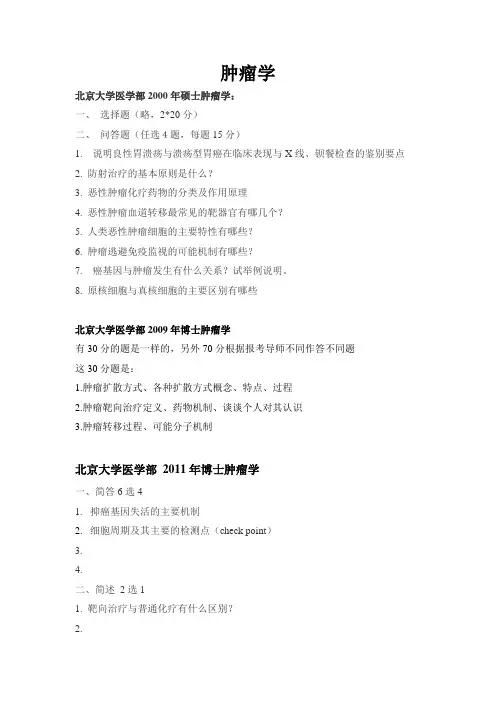
肿瘤学北京大学医学部2000年硕士肿瘤学:一、选择题(略,2*20分)二、问答题(任选4题,每题15分)1. 说明良性胃溃疡与溃疡型胃癌在临床表现与X线、钡餐检查的鉴别要点2. 防射治疗的基本原则是什么?3. 恶性肿瘤化疗药物的分类及作用原理4. 恶性肿瘤血道转移最常见的靶器官有哪几个?5. 人类恶性肿瘤细胞的主要特性有哪些?6. 肿瘤逃避免疫监视的可能机制有哪些?7. 癌基因与肿瘤发生有什么关系?试举例说明。
8. 原核细胞与真核细胞的主要区别有哪些北京大学医学部2009年博士肿瘤学有30分的题是一样的,另外70分根据报考导师不同作答不同题这30分题是:1.肿瘤扩散方式、各种扩散方式概念、特点、过程2.肿瘤靶向治疗定义、药物机制、谈谈个人对其认识3.肿瘤转移过程、可能分子机制北京大学医学部2011年博士肿瘤学一、简答6选41.抑癌基因失活的主要机制2.细胞周期及其主要的检测点(check point)3.4.二、简述2选11. 靶向治疗与普通化疗有什么区别?2.三、论述题2选11. 肿瘤抗原是什么?请设计一个实验,发现新的肿瘤抗原,并在临床予以验证。
2. 肿瘤的细胞分型与分子分型有什么不同?分子分型在临床的应用。
前面三大题是公选题(60分)。
后面的题是每个老师不同。
(40分)四、名词解释1. 调节性T细胞2.树突状细胞五、简述题1. 乳腺癌的分子分型为哪五种?哪一种更接近乳腺癌干细胞?2. 肿瘤的免疫治疗分类,请举例说明。
3. 化疗耐药的形成机制,针对此如何制定乳腺癌的治疗策略?复旦大学医学院2005年博士肿瘤学一. 简答题1.影像学在肿瘤中的作用2.综合治疗的重要性及其原则3.我国临床实验分几期,各期目的4.恶性肿瘤的转移途径5.微创外科中的无瘤原则6.原癌基因的活化机理,并举例说明7.什么是细胞调亡?肿瘤调亡与肿瘤治疗的关系8.宫颈癌的发病机制二、问答题1.凋亡的形态学及生化特点2.肿瘤外科生物学概念、临床意义3.肿瘤综合治疗分几部分复旦大学医学院2006年博士肿瘤学6道选5道1.DNA 的2种修复机制2.肿瘤的组织学来源3.试述临床研究方案的内容及注意事项4.基因扩增的检测方法5.防止肿瘤转移的治疗及方向6.肿瘤和遗传相关性的2个方面郑州大学2007年博士肿瘤学一.名词解释(每题2分):1.MTD 2.BSC 3.DD 4.DFS 5.EGFR二.问答(每题10分(1.消化肿瘤的主要特点?2.何谓恶病质,主要处理原则?3.肿瘤急性溶解综合征表现及其防治?4.上腔静脉综合征?5.请为CHOP治疗失败或复发的惰性淋巴瘤患者设计一个比较好的化疗方案6.目前骨肉瘤主要的三个化疗药物?7.癌发生的两阶段学说?8.癌细胞进入淋巴管、血管的过程?9.说出FDA批准的四个靶向治疗药物的适应症。
肿瘤学试卷试题库题集.doc
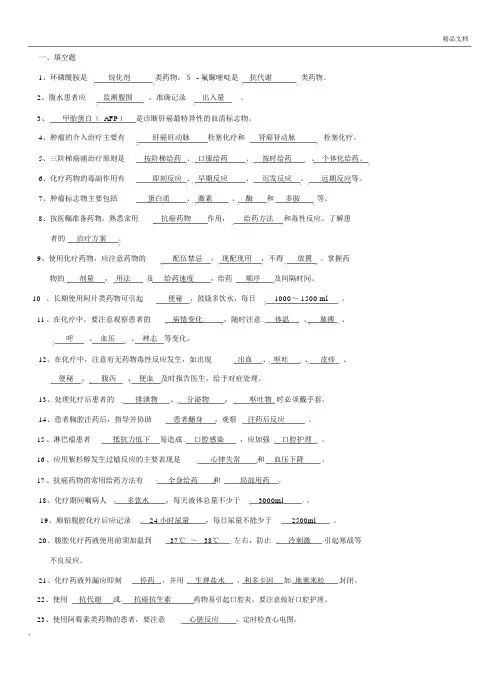
精品文档一、填空题1、环磷酰胺是烷化剂类药物,5 - 氟脲嘧啶是抗代谢类药物。
2、腹水患者应监测腹围,准确记录出入量。
3、甲胎蛋白( AFP)是诊断肝癌最特异性的血清标志物。
4、肿瘤的介入治疗主要有肝癌肝动脉栓塞化疗和肾癌肾动脉栓塞化疗。
5、三阶梯癌痛治疗原则是按阶梯给药、口服给药、按时给药、个体化给药。
6、化疗药物的毒副作用有即刻反应、早期反应、迟发反应、远期反应等。
7、肿瘤标志物主要包括蛋白质、激素、酶和多胺等。
8、按医瞩准备药物,熟悉常用抗癌药物作用,给药方法和毒性反应。
了解患者的治疗方案。
9、使用化疗药物,应注意药物的配伍禁忌,现配现用,不得放置。
掌握药物的剂量,用法及给药速度,给药顺序及间隔时间。
10 、长期使用阿片类药物可引起便秘,鼓励多饮水,每日1000~ 1500 ml 。
11 、在化疗中,要注意观察患者的病情变化,随时注意体温、脉搏、呼、血压、神志等变化。
12、在化疗中,注意有无药物毒性反应发生,如出现出血、呕吐、皮疹、便秘、腹泻、便血及时报告医生,给予对症处理。
13、处理化疗后患者的排泄物、分泌物,呕吐物时必须戴手套。
14、患者胸腔注药后,指导并协助患者翻身,观察注药后反应。
15 、淋巴瘤患者抵抗力低下易造成口腔感染,应加强口腔护理。
16 、应用紫杉醇发生过敏反应的主要表现是心律失常和血压下降。
17 、抗癌药物的常用给药方法有全身给药和局部用药。
18、化疗期间嘱病人多饮水,每天液体总量不少于3000ml 。
19、顺铂腹腔化疗后应记录24 小时尿量,每日尿量不能少于2500ml 。
20、腹腔化疗药液使用前须加温到37℃~38℃左右,防止冷刺激引起寒战等不良反应。
21、化疗药液外漏应即刻停药,并用生理盐水,利多卡因加地塞米松封闭。
22、使用抗代谢或抗癌抗生素药物易引起口腔炎,要注意做好口腔护理。
精品文档24、肝癌患者发生皮肤搔痒,可用 1 %薄荷乙醇溶液外涂,不可用力搔抓皮肤,以免皮肤破溃感染。
肿瘤学往年考题及其答案(有些学到之后大家自己补上吧)
02肿瘤考题1、放疗的原则答:(1)照射区域应包括原发灶及潜在的侵润范围,并应包括引流的淋巴结区。
(2)照射剂量根据治疗要求及肿瘤病理类型,癌细胞分级等决定治疗剂量。
(3)确定综合治疗方案为提高疗效可根据辅助治疗或根治治疗的目的、要求,安排综合治疗的项目,配合放疗的手术、化疗、生物治疗、热疗的时间、剂量等。
(4)保护正常组织与器官应做治疗计划。
(5)保持全身状况良好。
2、化疗药的种类及其作用机制答:根据药物作用的机制分为以下六类:(1)抗代谢类:通过阻断脱氧核苷酸合成,干扰DNA的合成;属于细胞周期时相特异性抗肿瘤药(2)烷化剂:通过烷化作用于DNA交叉联结,破坏DNA的结构和功能;属于细胞周期非特异性抗肿瘤药(3)干扰核酸合成中的转录过程,阻碍RNA的合成;属于细胞周期时相非特异性抗肿瘤药(4)拓扑异构酶抑制剂:抑制拓扑异构酶Ⅰ、Ⅱ,影响DNA合成,引起DNA断链;属于细胞周期时相非特异性抗肿瘤药(5)抗微管类:损伤纺锤体,使有丝分裂停滞;属于细胞周期特异性抗肿瘤药(6)分子靶向药物:蛋白激酶类抑制剂为主3、恶性肿瘤血行转移的主要靶器官答:肺、肝、骨、脑、肾上腺4、卵巢癌的主要转移途径答:通过直接蔓延及腹腔种植,瘤细胞可直接侵犯包膜及邻近器官并广泛种植于腹膜和大网膜表面;淋巴道也是重要的转移途径。
03本硕肿瘤学1、肿瘤侵袭和转移的机制答:①肿瘤细胞同质型粘附降低,从原发灶脱离;②肿瘤细胞与细胞外基质(ECM)发生异质型粘附增加;③ECM降解;肿瘤细胞与ECM中大分子作用,分泌蛋白降解酶类降解ECM成分,形成肿瘤细胞移动的通道,并以此为诱导血管生成的基础;④肿瘤细胞运动性增强在粘附降解的过程中移动,穿透ECM,并穿透血管壁的基底膜进入循环;⑤在循环中运行逃避免疫系统识别与破坏;⑥到达继发部位后,在有新生血管形成的前提下增殖,形成转移灶2、根据不同目的,化疗分哪几种?答:根治性化疗、辅助化疗、新辅助化疗、姑息性化疗、研究性化疗、局部化疗3、“无瘤原则”的定义答:无瘤原则--不接触的隔离技术1)在肿瘤的整个诊治过程中,通过加强对肿瘤观念的认识,注意各种操作规范,以及通过某些手段,防止和避免肿瘤的医源性播散。
肿瘤学试题库肿瘤总论
肿瘤学试题库肿瘤总论(共55页)--本页仅作为文档封面,使用时请直接删除即可----内页可以根据需求调整合适字体及大小--选择题A1型题1.肿瘤是指: D ()A.炎性增生形成的肿物B.修复过度形成的肿瘤包块C.代偿肥大所致D.异常增生而形成的新生物2.不符合...肿瘤性增生的是 B()A.增生的细胞具有异型性B.需致瘤因素的持续存在C.细胞代谢旺盛D.可不形成肿块E.相对无止境生长3.肿瘤性增生区别于炎症性增生的特点是 A()A.增生组织不分化不成熟B.血管增生C.纤维组织增生D.器官的实质细胞增生E.炎症细胞浸润4.有关肿瘤的生物学特性,下列哪项不正确:C()A.幼稚性B.与机体的不协调性C.致瘤因素消除后停止增生D.相对无限制生长5.有关肿瘤增生与炎性增生:D()A.两者无差异B.二者对机体均有利C.两者只有量的差异D.二者具有质的区别E. 二者对机体均不利6.肿瘤的实质是指:C()A.肿瘤的血管B.肿瘤的结构C.肿瘤细胞D.肿瘤的良恶性7.决定肿瘤特性的是:A()A.肿瘤的实质B.肿瘤的血管C.肿瘤的间质D.肿瘤的结构8.鉴定恶性肿瘤的组织起源和组织类型主要依据是:B()A.癌珠的形态B.肿瘤的实质形态C.肿瘤间质的类型D.肿瘤的生长方式E. 肿瘤实质与间质比例9.肿瘤的异型性是指:A()A.肿瘤与其起源组织的差异B.实质与间质比例的差异C.肿瘤之间大小的差异D.肿瘤之间的形态差异E. 肿瘤生长速度的差异10.区别良恶性肿瘤的重要形态学依据是:D()A.生长方式B.实质与间质的比例C.生长速度D.异型性E. 间质的类型11.恶性肿瘤异型性主要表现在C()A.肿瘤细胞胞浆嗜碱性B.可见核分裂C.肿瘤细胞核的多形性D.肿瘤细胞分泌减少E.组织结构紊乱12.良性肿瘤异型性主要表现在 C ()A.细胞形态不一B.核分裂像增多C.组织结构紊乱D.细胞间变明显E.细胞分泌减少13.不符合...肿瘤形态特点的描述的是 A()A.体积巨大的肿瘤多为恶性B.可发生多原发癌C.可形成微小癌D.可发生重复癌E.多为单发14.诊断恶性肿瘤的组织学依据主要是 C()A.细胞浆呈嗜碱性B.细胞核大C.细胞异型性明显D.核仁明显E.可见核分裂像15.恶性肿瘤最本质的表现是 C()A.浸润性生长B.生长迅速C.出现转移D.异型性明显E.有出血坏死16.良性肿瘤的最显著的特点是 E()A.异型性小B.生长缓慢C.不浸润周围组织D.出血坏死少见E.不转移17.良性肿瘤对机体的影响最主要决定于 D()A. 肿瘤的病程B. 肿瘤的大小C. 肿瘤组织的来源D. 肿瘤发生的部位E. 肿瘤出现继发性变化18.不符合...良性肿瘤对机体的影响的描述是 E()A. 可发生癌变B. 可引起内分泌紊乱C. 可发生出血囊性变D. 可浸润周围组织E. 可发生转移19.不符合...肿瘤代谢特点的是 E()、RNA合成代谢旺盛B.蛋白质合成代谢旺盛C.糖代谢以无氧酵解为主D.可产生肿瘤蛋白E.肿瘤标志物仅见于肿瘤组织20.大肠癌的肿瘤标志是 A()D.酸性磷酸酶E.碱性磷酸酶21.前列腺癌的肿瘤标志是 D()D.酸性磷酸酶E.碱性磷酸酶22.骨肉瘤的肿瘤标志是 E()D.酸性磷酸酶E.碱性磷酸酶23.肝细胞癌的肿瘤标志是 B()D.酸性磷酸酶E.碱性磷酸酶24.胰腺癌的肿瘤标志是 C()C. CA19-9D.酸性磷酸酶E.碱性磷酸酶25.中国城市居民死亡率居第一位的死因是: B()A.意外事故B.肿瘤C.冠心病D.高血压病E. 肺心病26.符合肿瘤防治现状的描述是 C()A.恶性肿瘤早期症状明显B.大多数中晚期癌的治疗效果满意C.早期发现、早期诊断、早期治疗具有重要意义D.公民对癌的防治意识已大幅度提高E.癌症的发病率不断下降27.符合癌的肉眼形态是A. 包膜完整B. 火山口状C. 分叶状D. 质地软E. 灰红色B28.弥漫型胃癌肉眼形态呈A.息肉状B.溃疡状C.弥漫浸润D.结节状E.囊状C29.女性,26岁,右乳外上象限有一直径约2cm大小的圆形肿块,边界清楚,表面光滑,可移动,不疼。
肿瘤学试题(附答案)
肿瘤学试题(附答案)一、单选题(共100题,每题1分,共100分)1、肿瘤的基本特征不包括( )。
A、细胞的异常生长B、肿瘤细胞的恶性行为是通过细胞增殖传递给子代细胞的C、保存了正常细胞的功能D、肿瘤是涉及遗传物质(DNA)结构和功能改变的疾病E、肿瘤细胞分化功能降低或丧失正确答案:C2、原发性肝癌按大体形态分型下述错误的是( )。
A、孤立的直径<5cm的癌结节称为小肝癌B、巨块型癌直径>10cmC、结节型易发生癌结节破裂出血D、巨块型易发生坏死引起肝破裂E、弥漫型往往因肝功能衰竭而死亡正确答案:C3、从放射生物学角度考虑,适合于加大分次剂量照射的肿瘤为( )。
A、脑胶质瘤B、肾癌C、肺癌D、前列腺癌E、淋巴瘤正确答案:D4、下列哪项是G2/M检测点的核心?( )A、CyclinDB、CDK2C、CyclinBlD、Cdc2E、CDK4正确答案:D5、制定GCP的目的除外( )。
A、保障受试者生命安全B、保证临床试验过程规范可靠C、保障受试者权益和隐私D、保证临床试验结果科学可信E、促进新药研发正确答案:E6、关于LAK细胞,下列说法错误的是( )。
A、较NK细胞具有更广谱的杀瘤作用B、具有细胞毒性效应C、其实质是NK细胞D、能被大剂量IL-2诱导E、其抗肿瘤的生物应答机制目前尚不十分清楚正确答案:C7、属于串联结构的器官是( )。
A、脊髓B、心脏C、肺D、肾E、肝正确答案:A8、子宫内膜癌当侵犯宫颈管时,其淋巴引流与哪种肿瘤相似?( )A、卵巢癌B、宫颈癌C、阴道癌D、直肠癌E、外阴癌正确答案:B9、人事招录、评审、聘任过程中应遵循( )原则。
A、公平、公正、公示B、公平、公开、公告C、公平、公正、公告D、公告、公示、公开E、公平、公正、公开正确答案:E10、不符合外阴尖锐湿疣的描述是( )。
A、鳞状上皮乳头状增生伴角化过度B、呈淡红色、乳头状、斑块状病变C、不累及子宫颈黏膜D、好发于外阴、肛周、阴道黏膜E、棘细胞层增生并形成空泡状细胞正确答案:C11、关于声门癌的描述正确的是( )。
肿瘤学~~大题汇总from 博济基础医学
07肿瘤考试部分选择●哪一种化疗药具有心脏毒性(阿霉素)●CEA在哪一种肿瘤检不出(喉癌?)●哪一项不是胃癌癌前疾病(旧题)(重度不典型增生)●死亡率最高的肿瘤●判断筛查效果的指标(活动期肿瘤发生率?早诊率?)●根除Hp可治愈哪种瘤?(胃粘膜相关)●局限于粘膜层的大肠癌发生淋巴结转移的几率?5?10??●细胞因子治疗最常见的副作用?(流感样症状?)●宫颈癌最常见的转移途径?●哪个药物属于强镇痛药(芬太尼)●甲状腺乳头状细胞癌淋巴结转移特点不包括什么(极少囊性变)●冰冻切片的适应症不包括什么(快速得到病理结果?)●哪个不是外科治疗原则●肺癌最常见的症状(咳嗽)●宫颈癌的随诊常用的肿瘤标记物(SCC)●晚期食管癌的病理类型(髓质型)●大肠癌最常见的病理类型(腺癌)●肝癌的特征性的肿瘤标志物(AFP)●术前定性诊断甲状腺癌最常用的方法(细针抽吸细胞学检查)●哪个不是高能射线的特征●鼻咽癌与什么病毒有关(EBV)●乳腺癌的必要条件(HPV)●鼻咽癌颅神经侵犯下面哪个错误●不常发于成人的肿瘤(视网膜母细胞膜)●鼻咽癌发病特征哪个错误(青少年比老年人发病率高)●哪个抗癌药物没有骨髓抑制(激素)●表浅食管癌的早期症状(胸骨后不适,摩擦感,微痛,吞咽异物感)●根除Hp可治愈哪种瘤?(胃粘膜相关)●局限于粘膜层的大肠癌发生淋巴结转移的几率?5?10??●细胞因子治疗最常见的副作用?(流感样症状?)●哪种肿瘤通常没有CEA升高?(喉癌)●宫颈癌最常见的转移途径?名解原位癌肿瘤伴随综合征亚临床期肝癌早期大肠癌新辅助化疗简答1.抗癌药物的种类及其作用机制2.外科手术中避免医源性肿瘤播散的方法病例1.食管癌诊断?依据?鉴别诊断?辅助检查?2.胃癌?同上+治疗原则06级肿瘤学部分选择题4.以下哪种不是肿瘤伴随综合征a 皮肌炎b 疼痛c 游走性血栓性静脉炎d 瘙痒e 黑棘皮病5有关诊断性活检手术的叙述,那一项是错误的a诊断性活检手术要合理选择手术类型b 诊断性活检手术的切口疤痕应摆放在下一次根治手术野内,方便切除c 诊断性手术获取的组织应足够病理诊断d 诊断性手术操作中可以在多个手术平面上广泛分离,以便暴露充分e 诊断性手术后报告为恶性,应尽快进行根治性治疗6无瘤原则和技术中不包括以下哪一点a无瘤原则和技术的应用并不能提高癌症患者的生存率 b 根治手术中应尽量避免双手直接接触肿瘤c根治手术后应该用大量蒸馏水冲洗手术创面d1967年turnbull在结直肠癌外科治疗中提出了“不接触技术”的无瘤概念 e 手术探查要由远及近,尽量采用锐性分离7下列肿瘤对放射线最敏感的是a腺癌b黑色素瘤c软组织肉瘤d 鳞癌e淋巴瘤8 高LET射线的特点是a电离密度大,传递给介质的能量高b相对生物效应少c对含氧状态依赖大d不利于杀伤乏氧细胞e对细胞周期中不同时相细胞的放射敏感性差异大9 下列哪个药物不属烷化剂a环磷酰胺b顺铂c氮芥d氮烯咪胺e 阿霉素16一下对于甲状腺未分化癌的描述,那一项不对a又称间变癌b以手术治疗为主c病变进展迅速d组织形态可分为小细胞癌、巨细胞癌和梭形细胞癌e 常见于50-69岁人群17关于肺癌类癌综合征的叙述,哪一项是错误的a由于癌组织中的嗜银细胞所产生的生物活性物质所致b多见于支气管类癌c多见于小细胞肺癌d表现为腹痛腹泻、面部潮红e患者可出现支气管痉挛18 有关肺癌的病理学,下面哪一项是错误的a周围型肺癌是指肿瘤发生在段和段支气管开口以下的支气管者b腺癌是最常见的组织学类型c 鳞癌以发生在中央型肺癌为主d小细胞肺癌恶性程度高,容易发生转移e肺癌出现扩散和转移并不与原发灶的大小有直接关系19 关于肺癌的外科治疗,下面哪一项不正确a早期非小细胞肺癌的首选治疗方法是手术切除b以肺叶切除加肺门纵膈淋巴结清扫为首选术式c必须按照最大限度切除肿瘤、最大限度保留肺组织的原则选择术式d小细胞肺癌是手术的绝对禁忌症e单一的远处转移是手术的相对禁忌症20 哪种病理类型的食管癌复发率较高a髓质型b蕈伞型c溃疡型d缩窄型e 腔内型27目前最常用的港爱普查手段是a肝脏B超+AFP检测b肝脏ct+AFP c 肝脏B超+肝炎抗原抗体检测d肝脏B超+肝功能检测e肝脏ct+肝功能检测28关于肝癌的治疗,以下说法不正确的是a手术切除仍是远期疗效最好的治疗手段b肝动脉栓塞化疗术是大多数不可切除患者的姑息性治疗选择c严格选择适应征的局部治疗可达到与手术接近的疗效d肝癌细胞对化疗药物敏感,全身化疗效果满意e 靶向治疗是未来的发展方向29胃的癌前疾病不包括a胃溃疡b胃息肉c残胃d重度不典型增生e胃黏膜巨大皱襞症30用于为爱术前分期的检查有a胃镜bX线钡餐c超声内镜d血清生物学指标e以前全是31 影响胃癌预后的主要因素是a肿瘤的浸润深度b淋巴结转移c手术方式 d 综合治疗e以上全是肿瘤医院见习考第十批简答:1.良恶性肿瘤鉴别2.外科治疗原则3.放疗治疗原则4.化疗毒性反应病例绝经后阴道流血7天,宫颈消失,一空洞性肿物,右侧侵犯至宫旁,左锁上淋巴结肿大问:初步诊断,与哪些疾病鉴别进行哪些检查来鉴别给出活检结果后再问:还需哪些检查给出PET结果后:临床分期,治疗原则CIN概念及分类2010年1月8号肿瘤见习试题1 良恶性肿瘤的病理学鉴别2 列举可以用化疗治愈的肿瘤,起码五个3 手术的无瘤原则4 肿瘤放射治疗剂量学四原则病例分析食管癌初步诊断和鉴别诊断食管癌的病变部位分段完善相关检查有锁骨上淋巴结和肝转移判断食管癌分期和治疗原则二院肿瘤见习第七轮简答1.肿瘤局部体检要注意哪些2.肿瘤化疗的毒性反应3.诊断性手术的类型4.放疗的治疗原则病例分析男,恶心呕吐,视矇,枕骨胀痛,步态缓慢,无咳嗽咳痰胸痛呼吸困难左锁骨上淋巴结肿大颅脑CT:小脑多发病灶1.初步诊断:小脑多发占位性病变查因,恶性肿瘤转移?鉴别诊断(3个以上)2.做哪些检查鉴别(5个以上)胸部CT:左肺2.5×3.0病灶,左肺门及纵膈旁淋巴结肿大,考虑周围型肺癌3.做哪些辅助检查(5个以上)病理活检:腺癌4.分期,治疗原则IV期,姑息性化疗5.分别解释上腔静脉阻塞综合征,Horner’s综合征,Pancoast’s综合征6级肿瘤学非选择题名解2*5Horner氏综合征研究性化疗错构瘤皮革胃宫颈上皮内瘤变病例15*21、48岁男,广东肇庆人,涕血、左耳鸣、头痛、左颈肿物3月余,鼻咽镜见左鼻咽侧壁结节状肿物,体检左上颈部3*3cm淋巴结质硬、活动、无压痛。
- 1、下载文档前请自行甄别文档内容的完整性,平台不提供额外的编辑、内容补充、找答案等附加服务。
- 2、"仅部分预览"的文档,不可在线预览部分如存在完整性等问题,可反馈申请退款(可完整预览的文档不适用该条件!)。
- 3、如文档侵犯您的权益,请联系客服反馈,我们会尽快为您处理(人工客服工作时间:9:00-18:30)。
肿瘤学北京大学医学部2000年硕士肿瘤学:一、选择题(略,2*20分)二、问答题(任选4题,每题15分)1. 说明良性胃溃疡与溃疡型胃癌在临床表现与X线、钡餐检查的鉴别要点2. 防射治疗的基本原则是什么?3. 恶性肿瘤化疗药物的分类及作用原理4. 恶性肿瘤血道转移最常见的靶器官有哪几个?5. 人类恶性肿瘤细胞的主要特性有哪些?6. 肿瘤逃避免疫监视的可能机制有哪些?7. 癌基因与肿瘤发生有什么关系?试举例说明。
8. 原核细胞与真核细胞的主要区别有哪些北京大学医学部2009年博士肿瘤学有30分的题是一样的,另外70分根据报考导师不同作答不同题这30分题是:1.肿瘤扩散方式、各种扩散方式概念、特点、过程2.肿瘤靶向治疗定义、药物机制、谈谈个人对其认识3.肿瘤转移过程、可能分子机制北京大学医学部2011年博士肿瘤学一、简答6选41.抑癌基因失活的主要机制2.细胞周期及其主要的检测点(check point)3.4.二、简述2选11. 靶向治疗与普通化疗有什么区别?2.三、论述题2选11. 肿瘤抗原是什么?请设计一个实验,发现新的肿瘤抗原,并在临床予以验证。
2. 肿瘤的细胞分型与分子分型有什么不同?分子分型在临床的应用。
前面三大题是公选题(60分)。
后面的题是每个老师不同。
(40分)四、名词解释1. 调节性T细胞2.树突状细胞五、简述题1. 乳腺癌的分子分型为哪五种?哪一种更接近乳腺癌干细胞?2. 肿瘤的免疫治疗分类,请举例说明。
3. 化疗耐药的形成机制,针对此如何制定乳腺癌的治疗策略?复旦大学医学院2005年博士肿瘤学一. 简答题1.影像学在肿瘤中的作用2.综合治疗的重要性及其原则3.我国临床实验分几期,各期目的4.恶性肿瘤的转移途径5.微创外科中的无瘤原则6.原癌基因的活化机理,并举例说明7.什么是细胞调亡?肿瘤调亡与肿瘤治疗的关系8.宫颈癌的发病机制二、问答题1.凋亡的形态学及生化特点2.肿瘤外科生物学概念、临床意义3.肿瘤综合治疗分几部分年博士肿瘤学2006复旦大学医学院.6道选5道1.DNA 的2种修复机制2.肿瘤的组织学来源3.试述临床研究方案的内容及注意事项4.基因扩增的检测方法5.防止肿瘤转移的治疗及方向个方面26.肿瘤和遗传相关性的郑州大学2007年博士肿瘤学一.名词解释(每题2分):1.MTD 2.BSC 3.DD 4.DFS 5.EGFR二.问答(每题10分(1.消化肿瘤的主要特点?2.何谓恶病质,主要处理原则?3.肿瘤急性溶解综合征表现及其防治?4.上腔静脉综合征?5.请为CHOP治疗失败或复发的惰性淋巴瘤患者设计一个比较好的化疗方案6.目前骨肉瘤主要的三个化疗药物?7.癌发生的两阶段学说?8.癌细胞进入淋巴管、血管的过程?9.说出FDA批准的四个靶向治疗药物的适应症。
华中科技大学同济医学院2006年博士肿瘤学一、名解(4*5)20分1 IGRT2 GCP3 VEGF4 TBI5 NCCN二、问答题80分1.简述肿瘤基因治疗的策略?1515简述霍杰金淋巴瘤的临床分期及治疗原则?2.3.WHO疼痛治疗原则?154.论述化疗药物机制和细胞周期的关系?155.鼻咽癌TNM分期,临床分期,治疗原则和技术?20华中科技大学同济医学院2008年博士肿瘤学简答题1。
亚临床灶2。
综合治疗3。
IGRT4。
EBM5。
GCP6。
OAR7。
干细胞8。
KPS评分9。
LET10。
论述题1。
试述DNA肿瘤病毒致癌机制2。
临床放疗剂量学四原则3。
非小细胞肺癌的临床分期和治疗原则4。
弥漫性大B细胞淋巴瘤的分期和治疗原则协和医科大学2002年博士肿瘤学1. 在诸多诱发肿瘤的病因中,如何认识遗传因素的作用?请指出遗传因素在肿瘤发生过程中的主要作用!2. 什么证据可以证明体细胞突变是启动癌变的主要原因?3. 简述“两次打击学说”,两次打击的主要内容?4. 软琼脂5. 简述在对人类肿瘤研究中,裸鼠致瘤实验的基本原理和意义;6. 简述C基本结构?简述交界性肿瘤?7.8. 放疗的原则?9. 为什么在我国推行TNM分期,为何反对诊断性放化疗?10. 外科治疗的原则和地位?11. 化疗在综合治疗中的地位以及可以取得的疗效?肿瘤内科在综合治疗中的地位12. 写出中文:del(20)(q41):20号染色体长臂4区1带缺失inv(12)(q13 p23):12号染色体倒位由长臂1区3带与短臂2区3带同时断裂倒位连接HLA:人类主要组织相容性复合体称为人白细胞抗原(human leukocyte antigen, HLA)。
MLTC:淋巴细胞肿瘤细胞混合培养(mixed lymphocyte tumor cell culture) ADCC:依赖抗体的细胞介导的细胞毒作用(ADCC)TSTA:肿瘤特异性移植抗原(tumor-specific transplantation antigen):在近交系动物,将移植瘤摘除后,可使动物产生特异性地抵抗同一种肿瘤的再次攻击,从而证实存在肿瘤特异性抗原(TSA)。
因采用肿瘤移植模型证实,又称为肿瘤特异性移植抗原(TSTA)。
CTL:细胞毒性体细胞(CTL)13. 名词解释:肿瘤流行病学:14. LAK和TIL的五个主要不同点?判断:15. 高能电子束,高能X射线,快中子以及质子束均可由加速器产生,并为临床放疗应用()16. DNA不能修复的双链断裂是辐射所致生物效应最基本的损伤()17. 放疗所用X线,能量越高,疗效约好(错)18. 足够大的手术切除范围,边缘镜检阴性,提示无临床病灶存在,术后无需放疗(错))术前、术中、术后放疗为放疗的三种基本形式(对19.20. 放疗会导致患者反应性不适,若患者急性反应越明显则提示晚期损伤越重(错)协和医科大学2007年肿瘤学1. 胃癌N分型。
2. 放疗R43. TNM的意义4. 肝癌肝移植5. 胰腺癌治疗的挑战6. 肝癌合并肝硬化脾功能亢进的治疗原则南方医科大学2005年博士肿瘤学一、简答题(6选4,每题15分)1.恶性肿瘤细胞放疗损伤的4R 变化及其临床意义。
2.肿瘤外科在恶性肿瘤多学科综合治疗中的地位。
3.自体造血干细胞移植的适应症。
对何种肿瘤最有效。
4.拓扑异构酶对恶性肿瘤的意义?举针对拓扑异构酶Ⅰ、Ⅱ的化疗药名各一个。
5.肿瘤多步骤转移机制。
6.细胞信号传导途径的基本组成要素。
二、论述题(选择二题,每题20分)7.从放疗的局部治疗角度论述放射治疗领域的新进展。
(何领域?何进展?反正是这方面)8.目前抗癌药物的开发和应用,除细胞毒药物外,尚有那些药物作用靶点。
并举例说明。
(内科考生必答)9.Indolent(非?)霍杰金淋病瘤的...(化疗方案?机理?效果?反正是治疗方面)(内科考生必答)10.食管癌吞钡造影X线的主要表现。
(胸科考生必答)11.肝癌行肝切除术后的并发症及其原因。
12.肝癌行肝动脉栓塞化疗的原理(及??)。
基因突变方式及其检测方法。
13.14.基因治疗策略。
15.烷化剂的作用机理。
举出3种药物名称。
(抗癌药理考生必答)16.说出化疗的毒性反应有那些方面?并各举出一个典型的药物名称。
(抗癌药理考生必答)17.甲状腺癌(肿瘤?)的诊断、影像(CT)和鉴别诊断。
(头颈科考生必答)18.根治性颈淋巴清扫术的并发症及其预防措施。
(头颈科考生必答)19.提高大肠癌疗效有那些措施。
20.腹部肿块按性质如何分类。
举例说明。
21.肺癌淋巴引流的肺和纵隔淋巴结分群与分组。
(胸科考生必答)南方医科大学2010年博士肿瘤学简答1. 肿瘤生物治疗的定义和种类2. 肿瘤放疗的主要进展3. 肿瘤化疗的基本原则4. 肿瘤个体化医学的基本含义5. 肿瘤分子分型的主要检测技术问答1. 何谓肿瘤NCCN的指南?请以晚期NSCLC规范化诊疗为例,谈如何做好肿瘤的多学科综合诊疗。
2. 晚期GIST新辅助治疗与一线治疗的思路有哪些主要区别?目前用于GIST一线治疗有哪些药物?如何根据不同分子分型采用不同用药方案?3. PET-CT在肿瘤诊断、治疗、预后等方面有哪些主要临床价值。
中南大学湘雅医学院2000年硕士肿瘤学一、名词解释1.肿瘤异质性2.接触性抑制3.间接致癌物、直接致癌物停泊非依赖性生长4.5.原位癌、浸润癌6.细胞周期限制点7.质粒载体8.肿瘤的三级预防9.凋亡二、问答1.你所了解的人类基因组计划以及生物信息学的进展(10分)2.你所了解的与人类肿瘤有关的DNA致病病毒及其与肿瘤的关系统(10分)3.你如何认识肿瘤4.你如何认识“肿瘤是一种环境与遗传相互作用的疾病”中南大学湘雅医学院2001年博士肿瘤学一、名词解释1.人类基因组计划(human genome projection)2.生物信息学(bioinformatics)3.DNA芯片4.细胞周期控制点(cell cycle check point)5.肿瘤的异质性(heterogencity)6.端粒酶(telomerase)7.细胞周期素(cyclins)8.肿瘤的化学预防(cancer chemoprevention)二、论述题1.癌变多阶段的分在基础2.凋亡的基本特点及其机制?在肿瘤发病中的意义3.肿瘤易感性的分子机制4.DNA致瘤病毒与人类肿瘤的关系5.如何认识肿瘤是一种环境因素参与的多基因疾病?部分来源不明博士肿瘤学、名解1一、.临床肿瘤学新辅助化疗、靶向治疗、异位内分泌综合征、上腔静脉综合征2、大题肿瘤疫苗延迟性腹泻,如何处理胃癌的癌前病变原发灶不明的转移瘤的诊断研究二、1、名解细胞因子、共刺激因子、粘附分子、2、大题人工免疫方法、作用抗感染免疫三、1名解肿瘤生物标志、微转移、错配修复基因及微卫星不稳定性细胞、热休克蛋白、二次打击学说、免疫监视2、大题肿瘤流行趋势三级预防措施根据生物治疗分类,举例说明靶向性、发生机制腺瘤性息肉叙述肿瘤免疫逃避机制,如何应用这些原理用于生物治疗四、1 细胞周期,凋亡的概念2 前瞻性研究和回顾性研究的优缺点3 肿瘤学的治疗方法(E)4 影像诊断学的作用术前放疗的作用56 驱邪与扶正在肿瘤治疗各个阶段的关系7 子宫内膜癌的治疗原则8 癌性慢性疼痛治疗的三步法9 肿瘤细胞的生物学特征五、辅助化疗的原理确诊宫颈癌的诊断是中医治疗的原则六、大题:1。
外科手术的分类有哪些?2。
肿瘤流行病学研究内容3。
肿瘤外科与普外科的不同点4。
放疗的副反应的分类及举例5。
the role of radiotherapy in the multi……treatment6。
放射线的分类7。
化疗的常见毒副反应第三军医大学2004年博士肿瘤学1.名词解释临床肿瘤学新辅助化疗靶向治疗三维适形治疗2.简答题(1)小细胞肺癌的放疗观点(2)举例说明什么是靶向治疗,至少三种以上(3)5-FU的药理机制及其衍生物的药理机制,举例说明问答题3.自体干细胞移植的适应症第三军医大学2005年博士肿瘤学一、名词解释:1.异位内分泌综合征2.解救化疗3.上腔静脉综合征4.肿瘤疫苗5.小肝癌二、问答:1.根据乳腺癌激素受体、淋巴结转移的不同,所采取的不同的内分泌治疗的情况?常用药物?用药时间?2.原发灶不明的转移瘤的诊断原则?3.胃癌的癌前病变有哪些?4.什么是延迟性腹泻?如何处理?(提示:在大肠癌的化疗中伊立替康引起)5.临床发现小肝癌的途径?三、病例分析主要是明确的非小细胞肺癌病例,让考生分析临床分期,设计化疗方案,药物,剂量,疗程,周期。
